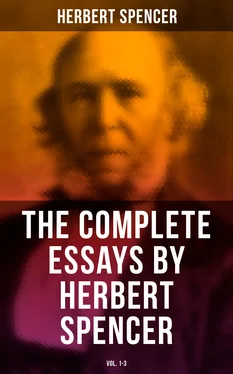The circulating mass of nutritive materials in individual organisms and in social organisms, becoming at once better in the quality of its ingredients and more heterogeneous in composition, as the type of structure becomes higher, eventually has added to it in both cases another element, which is not itself nutritive but facilitates the processes of nutrition. We refer, in the case of the individual organism, to the blood-discs; and in the case of the social organism, to money. This analogy has been observed by Liebig, who in his Familiar Letters on Chemistry says:—
"Silver and gold have to perform in the organism of the state, the same function as the blood-corpuscles in the human organism. As these round discs, without themselves taking an immediate share in the nutritive process, are the medium, the essential condition of the change of matter, of the production of the heat and of the force by which the temperature of the body is kept up, and the motions of the blood and all the juices are determined, so has gold become the medium of all activity in the life of the state."
And blood-corpuscles being like coin in their functions, and in the fact that they are not consumed in nutrition, he further points out that the number of them which in a considerable interval flows through the great centres, is enormous when compared with their absolute number; just as the quantity of money which annually passes through the great mercantile centres, is enormous when compared with the quantity of money in the kingdom. Nor is this all. Liebig has omitted the significant circumstance that only at a certain stage of organization does this element of the circulation make its appearance. Throughout extensive divisions of the lower animals, the blood contains no corpuscles; and in societies of low civilization, there is no money.
Thus far we have considered the analogy between the blood in a living body and the consumable and circulating commodities in the body-politic. Let us now compare the appliances by which they are respectively distributed. We shall find in the developments of these appliances parallelisms not less remarkable than those above set forth. Already we have shown that, as classes, wholesale and retail distributors discharge in a society the office which the vascular system discharges in an individual creature; that they come into existence later than the other two great classes, as the vascular layer appears later than the mucous and serous layers; and that they occupy a like intermediate position. Here, however, it remains to be pointed out that a complete conception of the circulating system in a society, includes not only the active human agents who propel the currents of commodities, and regulate their distribution, but includes, also, the channels of communication. It is the formation and arrangement of these to which we now direct attention.
Going back once more to those lower animals in which there is found nothing but a partial diffusion, not of blood, but only of crude nutritive fluids, it is to be remarked that the channels through which the diffusion takes place, are mere excavations through the half-organized substance of the body: they have no lining membranes, but are mere lacunæ traversing a rude tissue. Now countries in which civilization is but commencing, display a like condition: there are no roads properly so called; but the wilderness of vegetal life covering the earth's surface is pierced by tracks, through which the distribution of crude commodities takes place. And while, in both cases, the acts of distribution occur only at long intervals (the currents, after a pause, now setting towards a general centre and now away from it), the transfer is in both cases slow and difficult. But among other accompaniments of progress, common to animals and societies, comes the formation of more definite and complete channels of communication. Blood-vessels acquire distinct walls; roads are fenced and gravelled. This advance is first seen in those roads or vessels that are nearest to the chief centres of distribution; while the peripheral roads and peripheral vessels long continue in their primitive states. At a yet later stage of development, where comparative finish of structure is found throughout the system as well as near the chief centres, there remains in both cases the difference that the main channels are comparatively broad and straight, while the subordinate ones are narrow and tortuous in proportion to their remoteness. Lastly, it is to be remarked that there ultimately arise in the higher social organisms, as in the higher individual organisms, main channels of distribution still more distinguished by their perfect structures, their comparative straightness, and the absence of those small branches which the minor channels perpetually give off. And in railways we also see, for the first time in the social organism, a system of double channels conveying currents in opposite directions, as do the arteries and veins of a well-developed animal.
These parallelisms in the evolutions and structures of the circulating systems, introduce us to others in the kinds and rates of the movements going on through them. Through the lowest societies, as through the lowest creatures, the distribution of crude nutriment is by slow gurgitations and regurgitations. In creatures that have rude vascular systems, just as in societies that are beginning to have roads, there is no regular circulation along definite courses; but, instead, periodical changes of the currents—now towards this point and now towards that. Through each part of an inferior mollusk's body, the blood flows for a while in one direction, then stops and flows in the opposite direction; just as through a rudely-organized society, the distribution of merchandize is slowly carried on by great fairs, occurring in different localities, to and from which the currents periodically set. Only animals of tolerably complete organizations, like advanced communities, are permeated by constant currents that are definitely directed. In living bodies, the local and variable currents disappear when there grow up great centres of circulation, generating more powerful currents by a rhythm which ends in a quick, regular pulsation. And when in social bodies there arise great centres of commercial activity, producing and exchanging large quantities of commodities, the rapid and continuous streams drawn in and emitted by these centres subdue all minor and local circulations: the slow rhythm of fairs merges into the faster one of weekly markets, and in the chief centres of distribution, weekly markets merge into daily markets; while in place of the languid transfer from place to place, taking place at first weekly, then twice or thrice a week, we by-and-by get daily transfer, and finally transfer many times a day—the original sluggish, irregular rhythm, becomes a rapid, equable pulse. Mark, too, that in both cases the increased activity, like the greater perfection of structure, is much less conspicuous at the periphery of the vascular system. On main lines of railway, we have, perhaps, a score trains in each direction daily, going at from thirty to fifty miles an hour; as, through the great arteries, the blood moves rapidly in successive gushes. Along high roads, there go vehicles conveying men and commodities with much less, though still considerable, speed, and with a much less decided rhythm; as, in the smaller arteries, the speed of the blood is greatly diminished and the pulse less conspicuous. In parish-roads, narrower, less complete, and more tortuous, the rate of movement is further decreased and the rhythm scarcely traceable; as in the ultimate arteries. In those still more imperfect by-roads which lead from these parish-roads to scattered farmhouses and cottages, the motion is yet slower and very irregular; just as we find it in the capillaries. While along the field-roads, which, in their unformed, unfenced state, are typical of lacunæ , the movement is the slowest, the most irregular, and the most infrequent; as it is, not only in the primitive lacunæ of animals and societies, but as it is also in those lacunæ in which the vascular system ends among extensive families of inferior creatures.
Читать дальше












